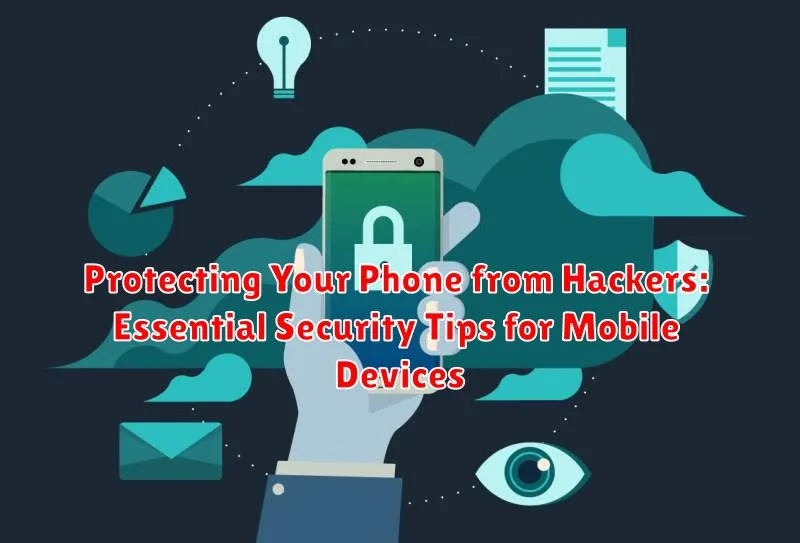In today’s interconnected world, our mobile devices have become indispensable tools, storing a wealth of sensitive information, from personal contacts and photos to financial details and access to various online accounts. This makes them prime targets for hackers. Protecting your phone from hackers is no longer optional, but a critical security measure to safeguard your privacy and prevent potential harm. This article explores essential security tips for mobile devices, equipping you with the knowledge and strategies needed to strengthen your phone’s defenses against evolving cyber threats. Learn how to fortify your device against malware, phishing scams, and unauthorized access, ensuring your valuable data remains safe and secure.
From implementing strong passwords and enabling two-factor authentication to recognizing and avoiding phishing attacks, understanding the potential vulnerabilities of your mobile device is the first step toward effective protection. We will delve into the specifics of mobile security, covering topics such as secure app downloads, Wi-Fi safety, and the importance of regular software updates. By implementing the essential security tips outlined in this guide, you can significantly reduce your risk of becoming a victim of mobile hacking and protect your phone and the valuable information it holds.
Understanding Common Mobile Security Threats
Mobile devices are vulnerable to various security threats, and understanding these threats is the first step in protecting your phone. Malware is a significant threat, often disguised as legitimate apps. These malicious programs can steal data, control your device, and even send premium-rate text messages without your knowledge.
Phishing attacks target mobile users through deceptive emails, text messages, or websites. These attacks aim to trick you into revealing sensitive information like passwords and credit card details. Spyware can secretly monitor your activities, collect personal data, and transmit it to third parties. This can include your location, browsing history, and even keystrokes.
Network attacks exploit vulnerabilities in public Wi-Fi networks to intercept your data. Connecting to unsecured networks exposes your device to potential eavesdropping and data theft. Lastly, physical device theft can also compromise your data if your phone isn’t properly secured.
Creating Strong Passwords and Enabling Two-Factor Authentication
Passwords are the first line of defense against unauthorized access. Create strong, unique passwords for each of your accounts, including your phone’s lock screen and individual apps. A strong password should be at least 12 characters long and include a mix of uppercase and lowercase letters, numbers, and symbols.
Avoid easily guessable passwords like “123456” or “password.” Consider using a password manager to generate and securely store complex passwords.
Two-Factor Authentication (2FA) adds an extra layer of security. Even if someone obtains your password, they’ll need a second factor to access your account. This second factor is typically a code sent to your phone via text, email, or an authenticator app.
Enable 2FA whenever possible. Most major online services and apps offer this feature. While slightly less convenient, it significantly enhances your account security.
Keeping Your Operating System and Apps Updated

One of the most effective ways to protect your phone is by keeping your operating system (OS) and apps updated. Updates frequently include crucial security patches that address known vulnerabilities. Hackers often exploit these vulnerabilities to gain access to your device, so installing updates promptly is paramount.
For most modern smartphones, OS updates can be set to install automatically. Enable this feature in your device’s settings to ensure you receive the latest security enhancements without manual intervention. Similarly, configure your apps to update automatically through your device’s app store. This practice minimizes the window of opportunity for hackers to exploit weaknesses in outdated software.
Regularly checking for updates manually is also recommended. While automatic updates are generally reliable, occasionally, updates may require manual confirmation or action. By proactively verifying that your OS and apps are up to date, you add another layer of protection to your mobile security.
Reviewing App Permissions and Data Access
Mobile apps often request access to various features and data on your phone, such as your camera, microphone, contacts, and location. While some of these permissions are necessary for the app to function properly, others may be excessive or even pose a security risk. It’s crucial to regularly review and manage the permissions granted to your apps.
Take the time to examine the permissions requested by each app. Ask yourself if the requested access makes sense in relation to the app’s functionality. For instance, a weather app likely needs access to your location, but a simple calculator app should not. If an app’s requested permissions seem suspicious or unnecessary, consider denying the request or uninstalling the app altogether.
Both iOS and Android provide tools to manage app permissions. You can typically find these settings in the privacy or security section of your phone’s settings menu. Regularly review these settings to ensure you are comfortable with the level of access granted to each app.
Be particularly cautious with apps that request access to sensitive data, such as your contacts, messages, or financial information. Only grant such permissions to trusted apps from reputable developers.
Avoiding Suspicious Links and Downloads
One of the easiest ways hackers gain access to your phone is through malicious links and downloads. Exercise caution before clicking any link, especially those received via text message or email from unknown senders. If a link seems suspicious, do not click it.
Similarly, be wary of downloading apps from untrusted sources. Stick to official app stores like the Apple App Store and Google Play Store. These platforms have security measures in place to vet apps, though some malicious apps can still slip through. Before downloading any app, carefully review the developer information, ratings, and user reviews to identify potentially harmful software.
When using a web browser on your phone, pay attention to the website address. Secure websites use HTTPS, indicated by a lock icon in the address bar. Avoid websites with misspellings or unusual characters in the URL, as these could be phishing sites designed to steal your information. Enable a pop-up blocker in your browser settings to prevent unwanted downloads or redirects to suspicious websites.
Installing a Reputable Mobile Security App
A crucial step in fortifying your phone’s security is installing a reputable mobile security app. These apps provide a suite of protective features designed to shield your device from various threats.
Choosing the right app is paramount. Look for well-known security companies with a proven track record. Read reviews and compare features before making a selection.
Key features to consider include:
- Malware scanning and removal: This core feature detects and eliminates malicious software that can compromise your device.
- Real-time protection: Provides continuous monitoring for threats as you use your phone.
- App scanning: Examines apps for suspicious permissions or behaviors before installation.
- Privacy protection features: May include features like anti-tracking and secure browsing.
Once installed, ensure the app is properly configured and updated regularly to maintain optimal protection against evolving threats.
Using a VPN for Secure Browsing and Data Transfer

A Virtual Private Network (VPN) adds a significant layer of security to your mobile browsing and data transfers. VPNs encrypt your internet traffic, making it much more difficult for hackers to intercept sensitive information like passwords, financial details, or browsing history, especially when using public Wi-Fi. This encryption shields your data from prying eyes, even on unsecured networks.
VPNs also mask your IP address, which is your device’s unique identifier on the internet. By masking your IP address, a VPN makes it harder for websites and trackers to monitor your online activities and build a profile of your habits. This provides an additional layer of privacy, preventing potential data breaches and targeted advertising.
Backing Up Your Phone Data Regularly
Regular backups are crucial for protecting your valuable data. A backup ensures you can recover your information in case of a device malfunction, loss, or a successful hacking attempt where data is compromised or deleted. Backing up frequently minimizes potential data loss.
Most modern smartphones offer built-in backup solutions. Cloud-based backups are a convenient option, syncing data automatically. For iOS devices, iCloud provides this functionality, while Android users can utilize Google Drive. Be sure to enable automatic backups for seamless protection.
Alternatively, you can back up your data locally to your computer. Connect your phone and follow the instructions for your operating system to back up your files, photos, and contacts. Remember to regularly update your backup as new data is generated on your phone.
Protecting Against Phishing Scams and Social Engineering Tactics
Phishing attacks and social engineering tactics aim to trick you into revealing sensitive information like passwords, credit card numbers, or social security details. These attacks can come through various channels, including text messages (SMS), emails, and phone calls.
Be wary of suspicious messages. Look for red flags such as poor grammar, misspellings, generic greetings (e.g., “Dear Customer”), urgent requests for action, or requests for personal information. Legitimate organizations rarely ask for such details via text or email.
Verify the sender’s identity. If you receive a message supposedly from a bank, company, or other organization, independently verify its authenticity. Contact the organization directly through their official website or phone number, not through any contact information provided in the suspicious message.
Think before you click. Avoid clicking on links or attachments in emails or text messages from unknown or untrusted sources. These links may lead to malicious websites designed to steal your information or infect your device with malware.
Be cautious of unsolicited calls. If you receive a call from someone claiming to represent a company or organization, be skeptical. Ask for their name, department, and a call-back number. Verify their identity independently before divulging any personal information.

